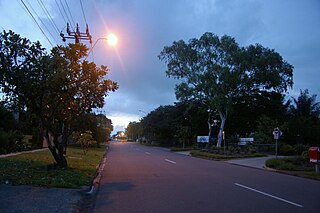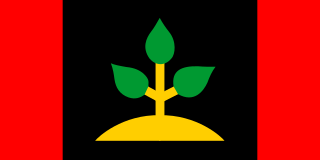
Darwin is the capital city of the Northern Territory, Australia. With a population of 139,902 at the 2021 census, the city contains the majority of the residents of the sparsely populated Northern Territory.

HMS Beagle was a Cherokee-class 10-gun brig-sloop of the Royal Navy, one of more than 100 ships of this class. The vessel, constructed at a cost of £7,803, was launched on 11 May 1820 from the Woolwich Dockyard on the River Thames. Later reports say the ship took part in celebrations of the coronation of King George IV of the United Kingdom, passing through the old London Bridge, and was the first rigged man-of-war afloat upriver of the bridge. There was no immediate need for Beagle, so she "lay in ordinary", moored afloat but without masts or rigging. She was then adapted as a survey barque and took part in three survey expeditions.

Darwin Harbour is the body of water close to Darwin in the Northern Territory of Australia. It opens to the north at a line from Charles Point in the west to Lee Point in the east into the Beagle Gulf and connects via the Clarence Strait with the Van Diemen Gulf. It contains Port Darwin, which is flanked by Frances Bay to the east and Cullen Bay to the west.

Circular Quay is a harbour, former working port and now international passenger shipping port, public piazza and tourism precinct, heritage area, and transport node located in Sydney, New South Wales, Australia on the northern edge of the Sydney central business district on Sydney Cove, between Bennelong Point and The Rocks. It is part of the local government area of the City of Sydney.

Nightcliff is a northern suburb of the city of Darwin, Northern Territory, Australia.

Adelaide River is a small but historically significant town located at the crossing of the Stuart Highway over the Adelaide River in the Northern Territory of Australia. The town is upstream of the Adelaide and Mary River Floodplains Important Bird Area. At the 2016 census, Adelaide River had a population of 353. Adelaide River is part of the Coomalie Shire and is the second largest settlement in the local government area.
The history of Darwin details the city's growth from a fledgling settlement into a thriving colonial capital and finally a modern city.

Larrakeyah is an inner suburb of Darwin, the capital city of Australia's Northern Territory. It was one of the first parts of the city to be developed, and borders the Darwin Central Business District. At the 2016 Census, there were 3,729 people in Larrakeyah. 54.9% of people were born in Australia. The next most common countries of birth were England 4.3%, Philippines 4.0% and New Zealand 2.7%. 66.0% of people spoke only English at home. The most common responses for religion were No Religion 31.8% and Catholic 23.5%. The suburb is located within the federal electorate of Solomon and the territory electorate of Port Darwin.

The Larrakia people are a group of Aboriginal Australian people in and around Darwin in the Northern Territory. The Larrakia, who refer to themselves as "Saltwater People", had a vibrant traditional society based on a close relationship with the sea and trade with neighbouring groups such as the Tiwi, Wadjiginy and Djerimanga. These groups shared ceremonies and songlines, and intermarried.

The Cherokee class was a class of brig-sloops of the Royal Navy, mounting ten guns. Brig-sloops were sloops-of-war with two masts rather than the three masts of ship sloops. Orders for 115 vessels were placed, including five which were cancelled and six for which the orders were replaced by ones for equivalent steam-powered paddle vessels.

Darwin City (referred to as Darwin city centre or The CBD is a suburb in metropolitan Darwin which comprises the original settlement, the central business district, parkland and other built-up areas. It is the oldest part of Darwin and includes many of the city's important institutions and landmarks, such as Parliament, Government House, the Northern Territory Supreme Court, Bicentennial Park and the George Brown Darwin Botanic Gardens. The city centre is located in the local government areas of the City of Darwin and the Darwin Waterfront Precinct.

Larrakeyah Barracks, incorporating HMAS Coonawarra, is the main base for the Australian Defence Force in the Northern Territory of Australia, and occupies the headland west of the suburb of Larrakeyah in the capital, Darwin. It was established in 1932–33, with building commencing in earnest in 1934, although many of the oldest structures were built in the early years of World War II.

Paul Foelsche was a South Australian police officer and photographer born in Germany, remembered for his work in the Northern Territory of Australia from 1870 to 1904.

Port Darwin is the port in Darwin, Northern Territory, in northern Australia. The port has operated in a number of locations, including Stokes Hill Wharf, Cullen Bay and East Arm Wharf. In 2015, a 99-year lease was granted to the Chinese-owned Landbridge Group, a transaction that has since ignited significant national security concerns.

HMAS HDML 1321, also known as Rushcutter was a 58-ton Harbour Defence Motor Launch (HMDL) of the Royal Australian Navy (RAN). Built by Purdon & Featherstone, Battery Point, Hobart, Tasmania and commissioned into the RAN on 11 November 1943, being the first Australian-built HDML to be commissioned and the last HDML in RAN service. She was assigned to Z Special Unit and delivered commandos for the 1945 ill-fated raid on Muschu Island. She was later reclassified as a Seaward Defence Boat and put into reserve after the war. She was recommissioned as HMAS Rushcutter in 1953 and used as an unarmed training vessel for the Royal Australian Naval Reserve and Australian Navy Cadets until 1970. Paid off in August 1971, she was converted to pleasure craft MV Rushcutter and is now based in Darwin.
The Darwin Waterfront Precinct is a tourist area in the Northern Territory of Australia in Darwin City. Restaurants, bars, a wave pool and a man-made beach are available for local community and tourists. It is located five minutes’ walk from the Darwin Central Business District (CBD).
The coastal coal-carrying trade of New South Wales involved the shipping of coal—mainly for local consumption but also for export or coal bunkering—by sea to Sydney from the northern and southern coal fields of New South Wales. It took place in the 19th and 20th centuries. It should not be confused with the export coal trade, which still exists today. There was also an interstate trade, carrying coal and coke to other Australian states that did not have local sources of black coal.

Wollongong Harbour Precinct is a heritage-listed shipping harbour at Cliff Road and Endeavour Drive, in Wollongong, New South Wales, Australia. It was built in 1837. The historic precinct includes Belmore Basin, Government Dam, Government Basin, Stockade Point, Flagstaff Hill, Signal Hill, Brighton Beach, Boat Harbour and Fortress Hill. It was added to the New South Wales State Heritage Register on 5 May 2010.

The Millers Point & Dawes Point Village Precinct is a heritage-listed retail shops that support harbour functions, office and urban residences located at Upper Fort Street, in the inner city Sydney suburb of Millers Point and Dawes Point in the City of Sydney local government area of New South Wales, Australia. It was built from 1788 to. It is also known as Millers Point, Goodye, Leightons Point, Jack the Millers Point, 'Dawes Point, Tar-ra, Parish St Philip, Flagstaff Hill, Cockle Bay Point, the Point and Fort Street. It was added to the New South Wales State Heritage Register on 28 November 2003. The precinct was formerly home to industrial buildings and urban residences.
East Arm is a suburb in the Northern Territory of Australia located in Darwin about 8 kilometres (5.0 mi) east of Darwin City overlooking a part of Darwin Harbour known as the East Arm.

















